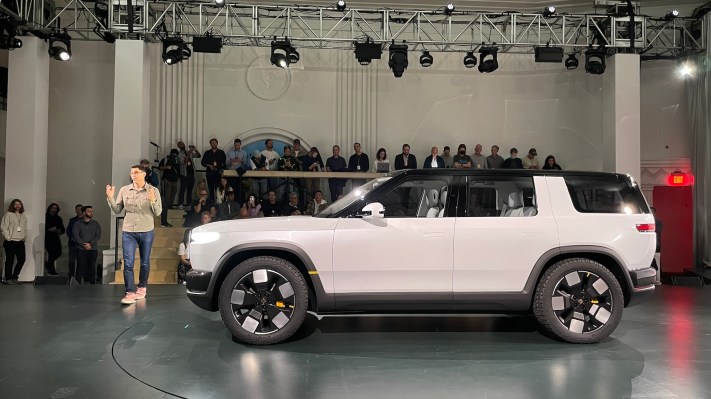As customers, VIP guests and media milled into the Rivian South Coast Theater in Laguna Beach on Thursday — the Pacific Ocean crashing on the beach just a few hundred feet away — a mix of hope and excitement rippled through the arena. The occasion was the unveiling of the Rivian R2, a smaller and more affordable all-electric SUV, and a vital vehicle for the EV upstart hoping to show the world it’s here to stay.
Early supporters of Rivian, friends, and founder RJ Scaringe’s young family filled the seats of the renovated theater. The air was filled with conversations about their Rivian vehicles, exclamations and congratulations, hugs and handshakes, and discussions of their hopes for the R2.
When the Rivian R2 did arrive, it did not come alone. Scaringe had two “one more thing moments,” showing off two more electric vehicles under the next-generation R3 platform, along with updates on production and hints about “adventure” accessories that will match up with the active lifestyle branding Rivian has become famous for.
The R2, a two-row, five-seat, all-electric midsized SUV that will have more than 300 miles of range and a base price of $45,000, was the main event. The encore was the smaller R3 and the R3x performance, a compact hatchback-style EV with sporty vibes.
A $2.25 billion move

Rivian founder and CEO RJ Scaringe talks about the R3, a surprise reveal Thursday, March 7. Image Credits: Kirsten Korosec
The R2, which customers can reserve starting today, will come in several powertrains, a single motor, a dual motor and a tri-motor version. Some of the biggest applause came when Scaringe announced that the company was moving up production of the R2 to the half first of 2026.
Tucked inside that announcement was a multibillion-dollar surprise. Scaringe said the R2 would be produced at the automaker’s Normal, Illinois, factory — a change from the company’s original plan to produce the R2 at a $5 billion factory near Atlanta, Georgia, that is just now under construction. That shift will save the company $2.25 billion.
Today, Rivian produces four vehicles at its sole factory in Normal: its two consumer vehicles, the R1T truck and the R1S SUV, and two versions of its commercial van.
John Krafcik, the former Waymo CEO and a Rivian board member, told TechCrunch on the sidelines the move to the Normal factory was the big story today — one that would give the automaker the ability to save money and get vehicles in customers’ hands sooner.
In a regulatory filing following the reveal, the company said beyond “significantly reducing the amount of capital needed to bring R2 to market, the company believes this approach considerably reduces risk to the launch and associated ramp; efficiently leverages its existing manufacturing and operations teams; and expands the total capacity for the site to 215,000 units per year.”
Onstage, Scaringe still gave a nod to the Georgia plant, noting that it was important to the company’s strategy to scale production of R2 and R3. However, it’s unclear when that Georgia plant will be back in play. The company said in the filing that “timing for resuming construction is expected to be later to focus its teams on the capital-efficient launch of R2 in Normal, Illinois.”
From handshake to hug
Scaringe called the company’s first EVs, the R1S and R1T, the company’s handshake to the world. The R2 and the R3, which sent the crowd abuzz — their hoots and howls echoing through the theater — was clearly designed as the full embrace.
Beaming onstage as he awaited the R3 to roll out, Scaringe seemed determined to send a message: Rivian has arrived.
The all-electric vehicle is still two years away from production. And when it emerges, the R2 will face an evolved EV market with more choices and players, many of which are expected to fall into the same, more affordable category. Scaringe and the design team have leaned into the R2 styling and accessories — the trademarks of its R1S and R1T.
Rivian promises the R2 will be something wholly different. It won’t just be lower cost, making it more accessible to a wider customer base, and produced at volume. The R2 will also reflect manufacturing maturity — a vehicle loaded with efficiencies that will finally lead Rivian down the path to profitability.
Rivian loses money on every R1S and R1T it makes, to the tune of $43,372 per unit delivered in the fourth quarter of 2023, according to regulatory filings. So finding efficiencies to reduce manufacturing costs as well as better deals with suppliers is critical to Rivian’s aim to make money on each vehicle it sells.
Scaringe highlighted how the company has worked on changes to reduce costs while preserving, even improving upon, the R1 vehicles.
The company is focused on vertically integrating electronics, further developing its software platform and packaging the battery and other components to improve manufacturability. The R2 is also loaded with sensors — 11 cameras and five radar — and more robust compute to support what Scaringe described as a high level of “self-driving.” He later added that the feature, which would be enabled on the highway, would allow drivers to get their hands off the wheel and eyes off the road.


